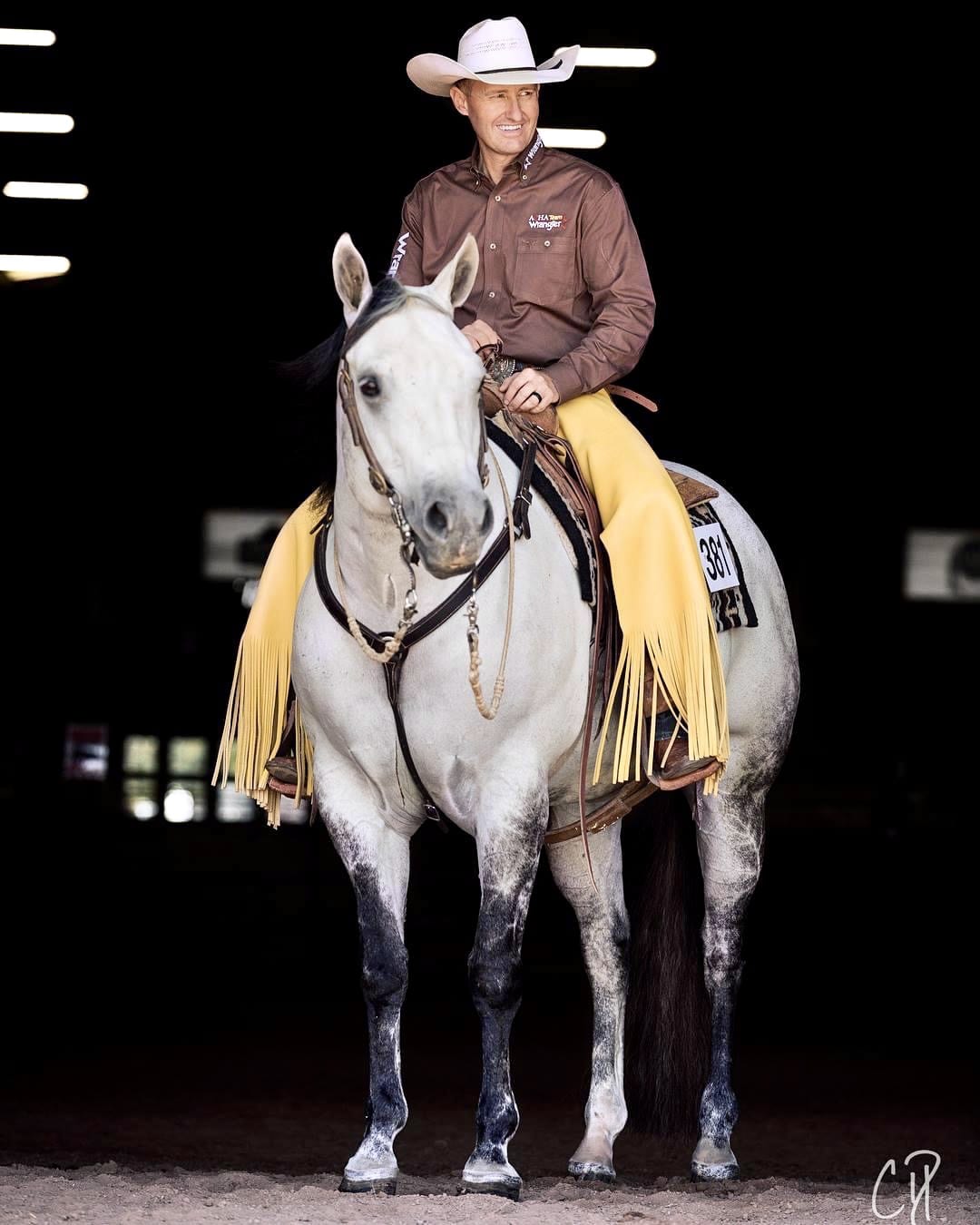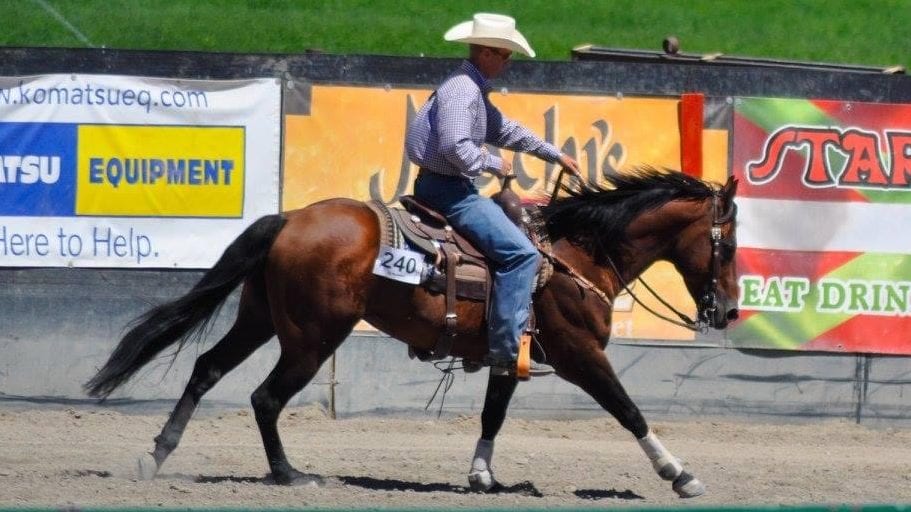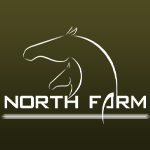With AQHA’s recent announcement that starting in 2021, more divisions will be added to its popular ranch riding class. Some exhibitors may be considering giving this popular class a try.
But the change from pleasure rider to ranch rider requires more than a wardrobe and tack change. Trainer Marty Simper of Elwood, Utah, offers some advice on simple ways to start readying your horse for a ranch riding debut.
First, exhibitors need to understand the purpose of the ranch riding horse: “to simulate a horse riding outside the confines of an arena and reflect the versatility, attitude, and movement of a working horse,” according to AQHA.
 This means that a horse that best fits the class is a horse that could be used all day long on a ranch doing various jobs; they need everything from the get-up-and-go to chase down a steer to the patience to stand quietly while his rider mends fences.
This means that a horse that best fits the class is a horse that could be used all day long on a ranch doing various jobs; they need everything from the get-up-and-go to chase down a steer to the patience to stand quietly while his rider mends fences.
“A good attitude goes a long way. Aside from that, I like a horse that keeps a good topline and makes easy transitions for the extended trot and the extended lope but is also willing to come back to me and be able to collect to that slower trot and lope. The point of ranch riding is to have that horse that you can do numerous techniques and maneuvers on. For all my ranch riding horses, I want a calm, quiet mind, so when I put them in new situations, like a new branding pen or new arena, they trust me to guide them through it,” Simper explains.
 With all of that said and a horse that is willing to work, a newbie to the ranch riding pen needs to leave their blinged-out tack or sparkly horsemanship top in the trailer and make that round top line and nose at the vertical a distant memory if ranch riding is something they’d like to pursue.
With all of that said and a horse that is willing to work, a newbie to the ranch riding pen needs to leave their blinged-out tack or sparkly horsemanship top in the trailer and make that round top line and nose at the vertical a distant memory if ranch riding is something they’d like to pursue.
This class is the definition of form to function. “A ranch rider has a little more of a cow-horse look to them. Their topline will either be flat or up with their neck out of their shoulders more. Ranch riders are meant to be pushed out in the bridle, giving the horse the ability to look out in front of himself, be aware of his surroundings and show expression,” Simper says.
Ranch riding is judged on the horse’s ability to work at a forward, working speed while performing the called-for maneuvers. And, because every gait is scored, movement plays a more prominent role than maneuvers. A correct, balanced, and cadenced horse who can extend is a right candidate for the class.
 A lack of extension in stride length will result in a penalty in the class. Beginning ranch riders whose roots are in the pleasure pen may struggle to leap a lope and an extended lope to a canter and all-out gallop that is desirable in ranch riding.
A lack of extension in stride length will result in a penalty in the class. Beginning ranch riders whose roots are in the pleasure pen may struggle to leap a lope and an extended lope to a canter and all-out gallop that is desirable in ranch riding.
“For someone starting, conquer the gaits. Your horse should have the ability to have a collected walk, extended walk, collected trot, extended trot, collected lope, and extended lope. Working your horse on all of those transitions helps you as the rider find the timing and rhythm of your horse,” Simper says. “Making those transitions neat and clean will help you greatly in the show pen.”
Once your horse is comfortable moving out, lateral movements should be another area of focus.
“Side-passing and two-tracking are the best first maneuvers a horse can learn because everything you do with your horse, you want them soft in your hands and to move off your legs. If they can side pass and two-track when you go to introduce a turnaround, your horse has already learned to cross over,” Simper says. “The same thing goes for a lead change. It helps your horse to keep itself picked up through that lead change and keep his belly underneath himself driving the shoulders up off the ground, staying forward, and moving with hind impulsion.”
 Simper also suggests teaching a horse to back up softly, which will help build their topline, engage their hind end, and keep them in the correct lead when loping circles.
Simper also suggests teaching a horse to back up softly, which will help build their topline, engage their hind end, and keep them in the correct lead when loping circles.
All of that work will lay the foundation for the successful execution of the class’s maneuvers. Required maneuvers in the class include the walk, jog and lope in both directions; the extended trot and extended lope in at least one direction; plus stops, a back, and at least one change of direction.
The pattern may also ask for a sidepass, 360 turns or greater, a lead change, walk, trot, or lope-over poles, or other “reasonable maneuvers a ranch horse could perform.” Like other pattern classes, ranch riding is scored on a 100 point scale, with 70 being an average performance.
Those new to the discipline may be surprised to learn that a horse shown in the western pleasure may not be shown in the ranch riding. This isn’t to say a horsemanship horse can’t cross into the world of ranch riding, though.
 “A horse that showed in horsemanship can cross over to ranch riding very easily. They can turn easy, have good transitions, and lead changes,” Simper says.
“A horse that showed in horsemanship can cross over to ranch riding very easily. They can turn easy, have good transitions, and lead changes,” Simper says.
A horsemanship rider would want to make sure they are more relaxed in their shoulders, back, and legs while showing in the ranch riding.
“You don’t want to be as posed and stiff. The idea is, you want to look like you could sit on that horse comfortably all day if you had to. Out on the ranch, you have long days of riding, and you want to be able to sit in a position you won’t tire easy from,” Simper says.
And by the looks of the continued growth in popularity of the class, no one is tiring easily from the challenges ranch riding brings.








